初中一年级英语语法汇总上课讲义
初中英语语法大全(详解)ppt课件
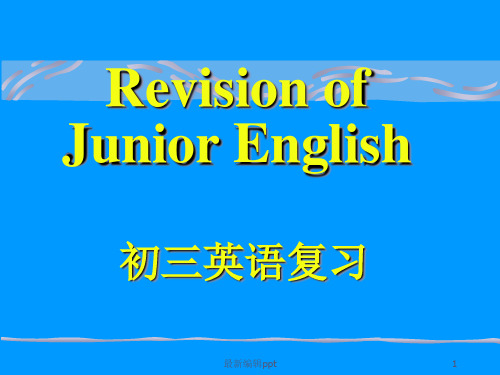
* They haven’t come back yet.
★ such 修饰名词 so 修饰形容词、副词
*I have never seen such an
interesting film.
*This box is so heavy that I can’t
carry it.
最新编辑ppt
3
★ alone(单独、独自)作表语=by oneself lonely(孤独的)可作表语、定语
你的英语越来越好了。
*These days more and more people are learning English.
现在学英语的人越来越多了。
最新编辑ppt
18
2. “the + 比较级,the + 比较级”
表示“ 越······就越······”
*The more, the better.
*He is the most careful among us.
最新编辑ppt
15
3) 在表示 “和······一样······” 和 “不及······” 这类概念时,可以用 “as+原级+as” 和 “not as(so)+ 原级+as”的句型
*Our teacher is as busy as before.
carefully - more carefully
- most carefully
最新编辑ppt
11
不规则变化
good/well – better – best many/much – more – most little – less – least far – farther – farthest ( far – further – furthest ) bad/badly/ill – worse – worst
初中一年级英语上册知识点归纳汇总

初中一年级英语上册知识点归纳汇总
以下是初中一年级英语上册的知识点归纳汇总:
1. 语法知识点:
- 介词的基本用法:用来表示时间、地点、方式等。
- 一般现在时的用法:表示经常性的动作或事实。
- 名词的单复数形式:可变名词的变化规则和不可变名词的特殊形式。
- 疑问代词的用法:用来提问人、事、地、物、方式等。
- 简单的动词时态:一般现在时、一般过去时和一般将来时的构成和用法。
2. 听力技巧:
- 听懂简单的对话和问题。
- 听懂简单的短文并获取相关信息。
- 听懂简单的指令和说明。
3. 词汇积累:
- 基本的日常用语和问候语。
- 常见的学科名词和动作动词。
- 数字、颜色、动物和食物等基础词汇。
4. 阅读技巧:
- 简单课文的阅读理解。
- 根据上下文猜测词义。
- 找出主题句和主要细节。
5. 口语表达:
- 能够用简单的句子进行日常交流。
- 能够介绍自己和他人的基本信息。
以上是初中一年级英语上册的知识点归纳汇总。
希望对你有帮助!。
初一英语语法知识点总结复习(最新超详细版)讲课稿
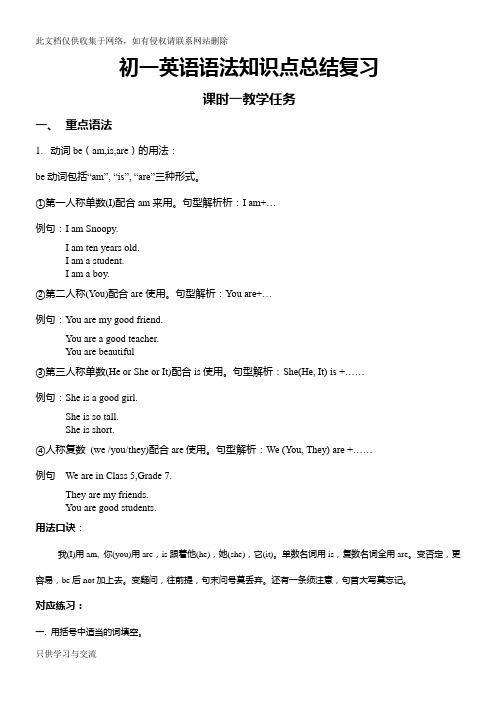
初一英语语法知识点总结复习课时一教学任务一、重点语法1.动词be(am,is,are)的用法:be动词包括“am”, “is”, “are”三种形式。
①第一人称单数(I)配合am来用。
句型解析析:I am+…例句:I am Snoopy.I am ten years old.I am a student.I am a boy.②第二人称(You)配合are使用。
句型解析:You are+…例句:You are my good friend.You are a good teacher.You are beautiful③第三人称单数(He or She or It)配合is使用。
句型解析:She(He, It) is +……例句:She is a good girl.She is so tall.She is short.④人称复数(we /you/they)配合are使用。
句型解析:We (You, They) are +……例句We are in Class 5,Grade 7.They are my friends.You are good students.用法口诀:我(I)用am, 你(you)用are,is跟着他(he),她(she),它(it)。
单数名词用is,复数名词全用are。
变否定,更容易,be后not加上去。
变疑问,往前提,句末问号莫丢弃。
还有一条须注意,句首大写莫忘记。
对应练习:一. 用括号中适当的词填空。
1. I ________(am, are, is) from Australia.2. She _______ (am, are, is) a student.3. Jane and Tom _________(am, is, are) my friends.4. My parents _______ (am, is, are) very busy every day.5. _______ (Are, Is, Do, Does) there a Chinese school in New York?6. _______ (Be, Are, Were, Was) they excited when he heard the news?7. There _____ (be) some glasses on it.8. If he _____ (be) free tomorrow, he will go with us.一、用be 动词的适当形式填空1. I ______ a boy. ______ you a boy? No, I _____ not.2. The girl______ Jack's sister.3. The dog _______ tall and fat.4. The man with big eyes _______ a teacher.5. ______ your brother in the classroom?6. Where _____ your mother? She ______ at home.7. How _______ your father?8. Mike and Liu Tao ______ at school.9. Whose dress ______ this?10. Whose socks ______ they?11. That ______ my red skirt.12. Who ______ I?13.The jeans ______ on the desk.14.Here ______ a scarf for you.15. Here ______ some sweaters for you.16. The black gloves ______ for Su Yang.17. This pair of gloves ______ for Yang Ling.18. The two cups of milk _____ for me.19. Some tea ______ in the glass.20. Gao shan's shirt _______ over there.第二课时(1)英语人称代词和物主代词一、人称代词表示“我”、“你”、“他”、“她”、“它”、“我们”、“你们”、“他们”的词,叫做人称代词。
(完整版)初中一年级英语语法总结
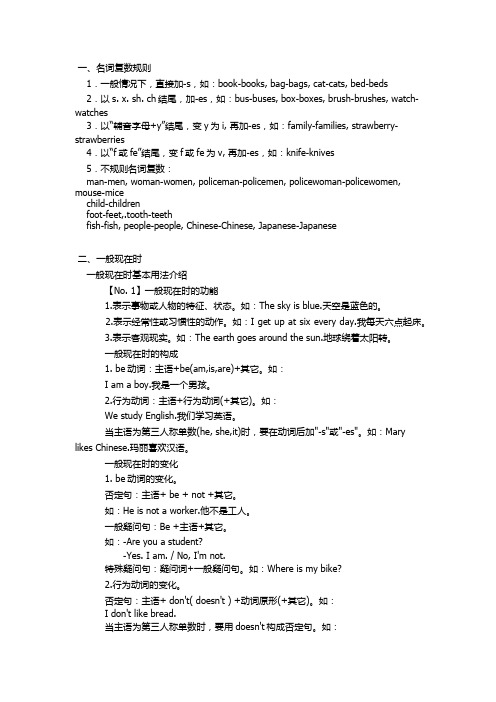
一、名词复数规则1.一般情况下,直接加-s,如:book-books, bag-bags, cat-cats, bed-beds2.以s. x. sh. ch结尾,加-es,如:bus-buses, box-boxes, brush-brushes, watch-watches3.以“辅音字母+y”结尾,变y为i, 再加-es,如:family-families, strawberry-strawberries4.以“f或fe”结尾,变f或fe为v, 再加-es,如:knife-knives5.不规则名词复数:man-men, woman-women, policeman-policemen, policewoman-policewomen, mouse-micechild-childrenfoot-feet,.tooth-teethfish-fish, people-people, Chinese-Chinese, Japanese-Japanese二、一般现在时一般现在时基本用法介绍【No. 1】一般现在时的功能1.表示事物或人物的特征、状态。
如:The sky is blue.天空是蓝色的。
2.表示经常性或习惯性的动作。
如:I get up at six every day.我每天六点起床。
3.表示客观现实。
如:The earth goes around the sun.地球绕着太阳转。
一般现在时的构成1. be动词:主语+be(am,is,are)+其它。
如:I am a boy.我是一个男孩。
2.行为动词:主语+行为动词(+其它)。
如:We study English.我们学习英语。
当主语为第三人称单数(he, she,it)时,要在动词后加"-s"或"-es"。
如:Mary likes Chinese.玛丽喜欢汉语。
一般现在时的变化1. be动词的变化。
初中英语语法重点知识点归纳与讲解

初中英语语法重点知识点归纳与讲解Title: Key Points and Explanation of Grammar in Junior High EnglishIntroduction:Grammar is an essential component of language learning. Understanding and applying correct grammar rules can greatly improve one's communication skills. In this article, we will discuss and explain some of the key points in English grammar for junior high students.1. Parts of Speech:- Nouns: Naming words that can represent a person, place, thing, or idea.- Pronouns: Words that substitute nouns, such as he, she, it, they, etc.- Verbs: Action or being words that express an action, occurrence, or state of being.- Adjectives: Words that describe nouns, adding more information or attributes.- Adverbs: Words that modify verbs, adjectives, or other adverbs, providing additional details.2. Verb Tenses:- Present tense: Used to express actions happening now or generally.- Past tense: Used to express actions that have already happened.- Future tense: Used to express actions that will happen in the future.- Present continuous: Used to express actions happening at the moment of speaking or in the near future.- Past continuous: Used to express ongoing actions that happened in the past for a specific duration.- Future continuous: Used to express ongoing actions that will happen in the future, emphasized over a specific duration.- Present perfect: Used to express actions that happened at an indefinite time before now or actions that are still ongoing.- Past perfect: Used to express actions completed before a specific point in the past.- Future perfect: Used to express actions that will be completed before a specific point in the future.3. Sentence Structure:- Subject and Predicate: A sentence contains a subject (the noun or pronoun indicating whom or what the sentence is about) and a predicate (the verb or verb phrase expressing the action or state of being).- Simple Sentences: A sentence consisting of a single subject and predicate.- Compound Sentences: A sentence containing two or more independent clauses joined together by a coordinating conjunction (e.g., and, but, or).- Complex Sentences: A sentence with an independent clause and one or more dependent clauses.- Sentence Fragments: Incomplete sentences that lack a subject, predicate, or both.- Run-on Sentences: Multiple independent clauses without proper punctuation or conjunction.4. Agreement:- Subject-Verb Agreement: The subject and verb in a sentence should agree in number and person.- Pronoun-Antecedent Agreement: Pronouns should match the noun they replace in gender and number.- Adjective-Noun Agreement: Adjectives should match the noun they modify in number and person.5. Modifiers:- Adjectives vs. Adverbs: Adjectives modify nouns, while adverbs modify verbs, adjectives, or other adverbs.- Comparative and Superlative Forms: Comparative forms compare two things, while superlative forms compare more than two things.- Position of Adjectives: Adjectives are usually placed before the noun they modify, but exceptions exist.Conclusion:Understanding and applying grammar rules is crucial for effective communication in English. By recognizing and mastering key points such as parts of speech, verb tenses, sentence structure, agreement, and modifiers, junior high students can significantly improve their language skills. Continuous practice and usage of these grammar rules will contribute to their overall development as English language learners.。
初中一年级英语要点
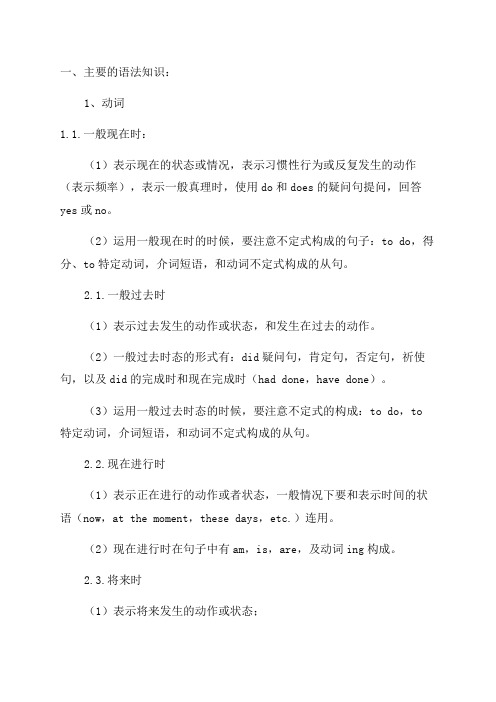
一、主要的语法知识:
1、动词
1.1.一般现在时:
(1)表示现在的状态或情况,表示习惯性行为或反复发生的动作(表示频率),表示一般真理时,使用do和does的疑问句提问,回答yes或no。
(2)运用一般现在时的时候,要注意不定式构成的句子:to do,得分、to特定动词,介词短语,和动词不定式构成的从句。
2.1.一般过去时
(1)表示过去发生的动作或状态,和发生在过去的动作。
(2)一般过去时态的形式有:did疑问句,肯定句,否定句,祈使句,以及did的完成时和现在完成时(had done,have done)。
(3)运用一般过去时态的时候,要注意不定式的构成:to do,to 特定动词,介词短语,和动词不定式构成的从句。
2.2.现在进行时
(1)表示正在进行的动作或者状态,一般情况下要和表示时间的状语(now,at the moment,these days,etc.)连用。
(2)现在进行时在句子中有am,is,are,及动词ing构成。
2.3.将来时
(1)表示将来发生的动作或状态;
(2)将来时以will,shall,be going to构成。
2.4.情态动词
(1)情态动词是用来表示说话人的态度,口气,客观可能性或者是不可能性;
(2)主要的情态动词:can,could,may,might,must,will,would,shall,should,ought to,had better。
2.5.祈使句。
初中英语语法精讲讲义(完整版)
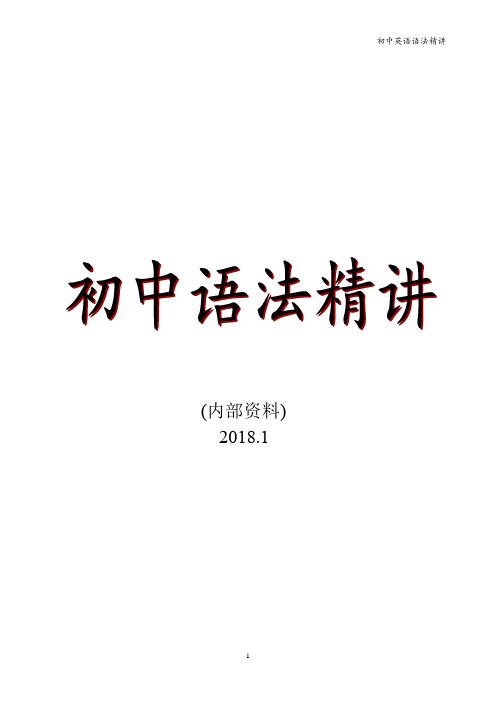
(内部资料) 2018.1目录第一讲名词第二讲冠词第三讲代词第四讲数词第五讲介词第六讲形容词和副词第七讲连词第八讲情态动词第九讲非谓语动词第十讲时态第十一讲被动语态第十二讲祈使句、倒装句、反意疑问句和感叹句第十三讲宾语从句第十四讲定语从句第十五讲状语从句第十六讲主谓一致第十七讲情景交际第十八讲词义辨析附录I 重点短语概述一、概述语法是研究词形变化和句子结构的科学,研究词形变化的部分成为词法(名词的数、格,动词的时态、语态),研究句子结构的部分称为句法(句子成分、语序,句子种类)。
二、英语词类词类英语作用在句中成分例词1名词n.表示人或物的名称主、宾、表、定、同位mother, son 2形容词adj.表示人或物的特征定、表、补、状big, small 3数词num.表示数目或顺序主、宾、nine, first 4代词pron.代替名词,数词主语宾语定语he, him, his 5动词v.表示动作或状态谓come, write 6副词adv.表示动作特征或性状特征状、表very, slowly 7冠词art.用在名词前说明其意义不做成分a, an, the8介词prep.用在名代前说明它与别的词之间的关系不做成分for, from, to 9连词conj.用来连接词与词或句与句不做成分and, but, if 10感叹词interj.表示说话时的感情或口气不做成分oh, ow三、句子成分句子中有两个最重要最基本的成分,主语和谓语。
除了主语和谓语,句子有时还有其他成分,宾语、定语、状语、表语等。
主语:一般位于句首,说明所要讲述的对象或主体,表示要说的“谁”或“什么”,一般由名词、代词或名词性的词类、短语或从句充当。
We often practise speaking English after class.Your father’s car is new.Watching English films is a good way to learn English.谓语:位于主语之后,说明主语的情况(动作或状态)---“做什么”“是什么”“怎么样”。
(完整版)初中一年级英语语法总结.doc

一、名词复数规则1 .一般情况下,直接加-s ,如: book-books, bag-bags, cat-cats, bed-beds2 .以 s. x. sh. ch 结尾,加 -es ,如: bus-buses, box-boxes, brush-brushes, watch-watches3 .以“辅音字母 +y ”结尾,变 y 为 i, 再加 -es ,如: family-families,strawberry-strawberries4 .以“f或 fe ”结尾,变 f 或 fe 为 v, 再加 -es,如: knife-knives5.不规则名词复数:man-men, woman-women, policeman-policemen, policewoman-policewomen,mouse-micechild-childrenfoot-feet,.tooth-teethfish-fish, people-people, Chinese-Chinese, Japanese-Japanese二、一般现在时一般现在时基本用法介绍【 No. 1 】一般现在时的功能1. 表示事物或人物的特征、状态。
如:The sky is blue. 天空是蓝色的。
2. 表示经常性或习惯性的动作。
如:I get up at six every day.我每天六点起床。
3.表示客观现实。
如: The earth goes around the sun. 地球绕着太阳转。
一般现在时的构成1. be 动词:主语 +be(am,is,are)+其它。
如:I am a boy. 我是一个男孩。
2.行为动词:主语 + 行为动词 (+ 其它 )。
如:We study English. 我们学习英语。
当主语为第三人称单数(he, she,it) 时,要在动词后加"-s" 或 "-es" 。
- 1、下载文档前请自行甄别文档内容的完整性,平台不提供额外的编辑、内容补充、找答案等附加服务。
- 2、"仅部分预览"的文档,不可在线预览部分如存在完整性等问题,可反馈申请退款(可完整预览的文档不适用该条件!)。
- 3、如文档侵犯您的权益,请联系客服反馈,我们会尽快为您处理(人工客服工作时间:9:00-18:30)。
2、代词项目人称代词物主代词指示代词反身代词人称主格宾格形容词名词性第一人称单数 I me my mine myself复数 we us our ours ourselves第二人称单数 you you your yours yourself复数 you you your yours yourselves第三人称单数 she her her hers herselfhe him his his himselfit it its its this that itself复数 they them their theirs these those themselves3、动词A)第三人称单数当动词是第三人称单数时,动词应该像名词的单数变动词那样加s,如下:一)一般在词后加s。
如:comes, spells, waits, talks, sees, dances, trains二)在x, sh, ch, s, tch后加es。
如:watches, washes, wishes, finishes三)1)以辅音字母加y结尾的变y为i再加es。
如:study-studies, hurry-hurries, try-tries2)以元音字母加y结尾的直接加s。
如:plays, says, stays, enjoys, buys四)以o结尾加es。
如:does, goes五)特殊的有:are-is, have-hasB)现在分词当我们说某人正在做什么事时,动词要使用分词形式,不能用原形,构成如下:一)一般在后加ing。
如:spell-spelling, sing-singing, see-seeing, train-training, play-playing,hurry-hurrying, watch-watching, go-going, do-doing二)以不发音e的结尾的去掉e再加ing。
如:dance-dancing, wake-waking,take-taking,practice-practicing, write-writing, have-having三)以重读闭音节结尾且一个元音字母+一个辅音字母(注意除开字母组合如show –showing,draw-drawing)要双写最后的辅音字母再加ing。
如:put-putting, run-running, get-getting,let-letting, begin-beginning四)以ie结尾的变ie为y再加ing。
如:tie-tying系 die-dying死 lie-lying 位于4、形容词的级我们在对两个或以上的人或物进行对比时,则要使用比较或最高级形式。
构成如下:一)一般在词后加er或est(如果是以e结尾则直接加r或st)。
如:greater-greatest, shorter –shortest,taller –tallest, longer –longest, nicer- nicest, larger -largest二)以重读闭音节结尾且1个元音字母+1个辅音字母(字母组合除外,如few-fewer fewest)结尾的双写结尾的辅音再加er /est。
如:big-bigger biggest, red-redder reddest, hot-hotter hottest三)以辅音字母+y结尾的变y为i加er/est。
如:happy-happier happiest, sorry-sorrier sorriest,friendly-friendlier friendliest(more friendly most friendly), busy-busier busiest, easy-easier easiest四)特殊情况:(两好多坏,一少老远)good/well - better best many/much - more most bad/ill – worse worstlittle- less least old- older/elder oldest/eldest far- farther/further farthest/furthest5、数词 (基变序,有规则;一、二、三,自己背;五、八、九、十二;其它后接th;y结尾,变为i, eth跟上去。
) first, second, third; fifth, eighth, ninth, twelfth; seventh, tenth, thirteenth, hundredth;twenty-twentieth, forty-fortieth, ninety-ninetieth二、句式1、一般现在时表示普遍、经常性的或长期性的动作时使用一般现在时,它有:1.陈述句肯定陈述句 a) This is a book. (be动词)b) He looks very young. (连系动词)c) I want a sweat like this. (实义动词)d) I can bring some things to school. (情态动词)e) There’s a computer on my desk. (There be结构)否定陈述句 a) These aren’t their books.b) They don’t look nice.c) Kate doesn’t go to No. 4 Middle School.d) Kate can’t find her doll.e) There isn’t a cat here. (=There’s no cat here.)2. 祈使句肯定祈使句 a) Please go and ask the man.b) Let’s learn English!c) Come in, please.否定祈使句a) Don’t be late.b) Don’t hurry.3. 疑问句1) 一般疑问句 a) Is Jim a student?b) Can I help you?c) Does she like salad?d) Do they watch TV?e) Is she reading?肯定回答: a) Yes, he is.b) Yes, you can.c) Yes, she does.d) Yes, they do.e) Yes, she is.否定回答: a) No, he isn’t.b) No, you can’t.c) No, she doesn’t.d) No, they don’t.e) No, she isn’t.2) 选择疑问句 Is the table big or small? 回答 It’s big./ It’s small.3) 特殊疑问句①问年龄 How old is Lucy? She is twelve.②问种类 What kind of movies do you like? I like action movies and comedies.③问身体状况 How is your uncle? He is well/fine.④问方式 How do/can you spell it? L-double O-K.How do we contact you? My e-mail address is cindyjones@.⑤问原因 Why do you want to join the club?⑥问时间 What’s the time? (=What time is it?) It’s a quarter to ten a.m..What time do you usually get up, Rick? At five o’clock.When do you want to go? Let’s go at 7:00.⑦问地方 Where’s my backpack? It’s under the table.⑧问颜色 What color are they? They are light blue.What’s your favourite color? It’s black.⑨问人物 Who’s that? It’s my sister.Who is the boy in blue? My brother.Who isn’t at school? Peter and Emma.Who are Lisa and Tim talking to?⑩问东西 What’s this/that (in English)? It’s a pencil case.What else can you see in the picture? I can see some broccoli, strawberries and hamburgers.11问姓名 What’s your aunt’s name? Her name is Helen./She’s Helen.What’s your first name? My first name’s Ben.What’s your family name? My family name’s Smith.12 问哪一个 Which do you like? I like one in the box.13 问字母 What letter is it? It’s big D/small f.14 问价格 How much are these pants? They’re 15 dollars.15 问电话号码 What’s your phone number? It’s 576-8349.16 问谓语(动作) What’s he doing? He’s watching TV.17 问职业(身份) What do you do? I’m a teacher.What’s your father? He’s a doctor.三、时态Be 动词:She’s a worker. Is she a worker? She isn’t a worker.情态动词:I can play the piano. Can you play the piano? I can’t play the piano.行为动词:They want to eat some tomatoes. Do they want to eat any tomatoes?They don’t want to eat any tomatoes.Gina has a nice watch. Does Gina have a nice watch? Gina doesn’t have a watch.2、现在进行时表示动词在此时正在发生或进行就使用进行时态,结构为sb be v-ing sth + 其它.I’m playing baseball. Are you playing baseball? I’m not playing baseball.Nancy is writing a letter. Is Nancy writing a letter? Nancy isn’t writing a letter.They’re listening to the pop music. Are they listening the pop music?They aren’t listening to the pop music.。
